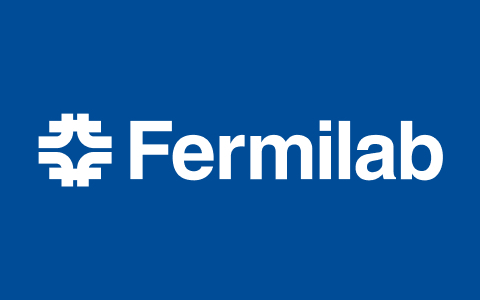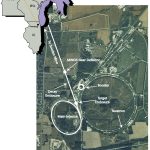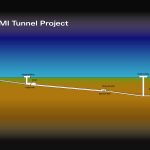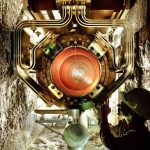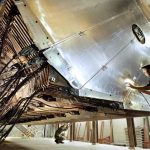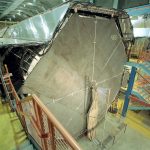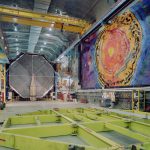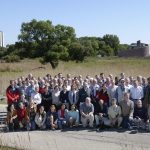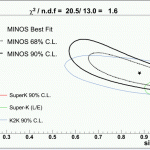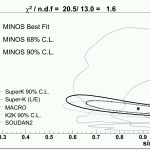BATAVIA, Illinois—An international collaboration of scientists at the Department of Energy’s Fermi National Accelerator Laboratory announced today (March 30, 2006) the first results of a new neutrino experiment. Sending a high-intensity beam of muon neutrinos from the lab’s site in Batavia, Illinois, to a particle detector in Soudan, Minnesota, scientists observed the disappearance of a significant fraction of these neutrinos. The observation is consistent with an effect known as neutrino oscillation, in which neutrinos change from one kind to another. The Main Injector Neutrino Oscillation Search (MINOS) experiment found a value of delta m2 = 0.0031 eV2, a quantity that plays a crucial role in neutrino oscillations and hence the role of neutrinos in the evolution of the universe.
“Only a year ago we launched the MINOS experiment,” said Fermilab Director Pier Oddone. “It is great to see that the experiment is already producing important results, shedding new light on the mysteries of the neutrino.”
Nature provides for three types of neutrinos, yet scientists know very little about these “ghost particles,” which can traverse the entire Earth without interacting with matter. But the abundance of neutrinos in the universe, produced by stars and nuclear processes, may explain how galaxies formed and why antimatter has disappeared. Ultimately, these elusive particles may explain the origin of the neutrons, protons and electrons that make up all the matter in the world around us.
“Using a man-made beam of neutrinos, MINOS is a great tool to study the properties of neutrinos in a laboratory-controlled environment,” said Stanford University professor Stan Wojcicki, spokesperson of the experiment. “Our first result corroborates earlier observations of muon neutrino disappearance, made by the Japanese Super-Kamiokande and K2K experiments. Over the next few years, we will collect about fifteen times more data, yielding more results with higher precision, paving the way to better understanding this phenomenon. Our current results already rival the Super-Kamiokande and K2K results in precision.”
Neutrinos are hard to detect, and most of the neutrinos traveling the 450 miles from Fermilab to Soudan–straight through the earth, no tunnel needed–leave no signal in the MINOS detector. If neutrinos had no mass, the particles would not change as they traverse the Earth and the MINOS detector in Soudan would have recorded 177 +/- 11 muon neutrinos. Instead, the MINOS collaboration found only 92 muon neutrino events–a clear observation of muon neutrino disappearance and hence neutrino mass. The deficit as a function of energy is consistent with the hypothesis of neutrino oscilations and yields a value of delta m2, the square of the mass difference between two different types of neutrinos, equal to 0.0031 eV2 +/- 0.0006 eV2 (statistical uncertainty) +/- 0.0001 eV2 (systematic uncertainty). In this scenario, muon neutrinos can transform into electron neutrinos or tau neutrinos, but alternative models–such as neutrino decay and extra dimensions–are not yet excluded. It will take the recording of much more data by the MINOS collaboration to test more precisely the exact nature of the disappearance process.
Details of the current MINOS results will be presented by David Petyt of the University of Minnesota at a special seminar at Fermilab on March 30, 2006, at 4:00 p.m. A day later, the MINOS collaboration will commemorate MINOS co-spokesperson Doug Michael at a memorial service at Fermilab. Michael, senior research associate at Caltech, died at age 45 on December 25, 2005, after a year-long battle with cancer.
The MINOS experiment includes about 150 scientists, engineers, technical specialists and students from 32 institutions in 6 countries, including Brazil, France, Greece, Russia, the United Kingdom and the United States. The institutions include universities as well as national laboratories. The U.S. Department of Energy provides the major share of the funding, with additional funding from the U.S. National Science Foundation and from the United Kingdom’s Particle Physics and Astronomy Research Council.
“The MINOS experiment is a hugely important step in our quest to understand neutrinos–we have created neutrinos in the controlled environment of an accelerator and watched how they behave over very long distances,” said Professor Keith Mason, CEO of PPARC. “This has told us that they are not totally massless as was once thought, and opens the way for a detailed study of their properties. UK scientists have taken key roles in developing the experiment and in exploiting the data from it, the results of which will shape the future of this branch of physics.”
The Fermilab side of the MINOS experiment consists of a beam line in a 4,000-foot-long tunnel pointing from Fermilab to Soudan. The tunnel holds the carbon target and beam focusing elements that generate the neutrinos from protons accelerated by Fermilab’s Main Injector accelerator. A neutrino detector, the MINOS “near detector” located 350 feet below the surface of the Fermilab site, measures the composition and intensity of the neutrino beam as it leaves the lab. The Soudan side of the experiment features a huge 6,000-ton particle detector that measures the properties of the neutrinos after their 450-mile trip to northern Minnesota. The cavern housing the detector is located half a mile underground in a former iron mine.
The MINOS neutrino experiment follows up on the K2K long-baseline neutrino experiment in Japan. From 1999-2001 and 2003-2004, the K2K experiment in Japan sent neutrinos from an accelerator at the KEK laboratory to a particle detector in Kamioka, a distance of about 150 miles. Compared to K2K, the MINOS experiment uses a three times longer distance, and the intensity and the energy of the MINOS neutrino beam are higher than the K2K beam. These advantages have enabled the MINOS experiment to observe in less than one year about three times more neutrinos than the K2K experiment did in about four years.
“It is a great gift for me to hear this news,” said Yoji Totsuka, former spokesperson of the Super-Kamiokande experiment and now Director General of KEK. “Neutrino oscillation was first established in 1998, with cosmic-ray data taken by Super-Kamiokande. The phenomenon was then corroborated by the K2K experiment with a neutrino beam from KEK. Now MINOS gives firm results in a totally independent experiment. I really congratulate their great effort to obtain the first result in such a short time scale.”
Fermi National Accelerator Laboratory, founded in 1967, is a Department of Energy National Laboratory in Batavia, Illinois, about 40 miles west of Chicago. Fermilab operates the world’s highest-energy particle accelerator, the Tevatron, on its 6,800-acre campus. About 2,300 physicists from universities and laboratories around the world conduct physics experiments using Fermilab’s accelerators to discover what the universe is made of and how it works. Discoveries at Fermilab have resulted in remarkable new insights into the nature of the world around us. Fermilab is operated by Universities Research Association, Inc., a consortium of 90 research universities, for the United States Department of Energy, which owns the laboratory.
More information on the MINOS experiment is at www-numi.fnal.gov
A 12-minute streaming video on the MINOS experiment is at http://vmsstreamer1.fnal.gov/VMS_Site_02/VMS/MINOS/MINOS.htm
| Argonne National Laboratory
University of Athens (Greece) Benedictine University Brookhaven National Laboratory Cal Tech University of Cambridge (U.K.) Fermilab College de France Harvard University Illinois Institute of Technology Indiana University ITEP-Moscow Lebedev Physical Institute Lawrence Livermore National Laboratory University College, London (U.K.) University of Minnesota University of Minnesota-Duluth |
Oxford University (U.K.)University of Pittsburgh
IHEP-Protvino Rutherford Appleton Lab (U.K.) University of Sao Paulo (Brazil) Soudan Underground Laboratory University of South Carolina Stanford University University of Sussex (U.K.) Texas A&M University University of Texas at Austin Tufts University UNICAMP (Brazil) Western Washington University University of Wisconsin College of William and Mary |
- Neutrinos, ghost-like particles that rarely interact with matter, travel 450 miles straight through the earth from Fermilab to Soudan — no tunnel needed. The Main Injector Neutrino Oscillation Search (MINOS) experiment studies the neutrino beam using two detectors. The MINOS near detector, located at Fermilab, records the composition of the neutrino beam as it leaves the Fermilab site. The MINOS far detector, located in Minnesota, half a mile underground, again analyzes the neutrino beam. This allows scientists to directly study the oscillation of muon neutrinos into electron neutrinos or tau neutrinos under laboratory conditions.
- Fermilab completed the construction and testing of the Neutrino at the Main Injector (NuMI) beam line in early 2005. Protons from Fermilab’s Main Injector accelerator (left) travel 1,000 feet down the beam line, smash into a graphite target and create muon neutrinos. The neutrinos traverse the MINOS near detector, located at the far end of the NuMI complex, and travel straight through the earth to a former iron mine in Soudan, Minnesota, where they cross the MINOS far detector. Some of the neutrinos arrive as electron neutrinos or tau neutrinos.
- When operating at highest intensity, the NuMI beam line transports a package of 35,000 billion protons every two seconds to a graphite target. The target converts the protons into bursts of particles with exotic names such as kaons and pions. Like a beam of light emerging from a flashlight, the particles form a wide cone when leaving the target. A set of two special lenses, called horns (photo), is the key instrument to focus the beam and send it in the right direction. The beam particles decay and produce muon neutrinos, which travel in the same direction. Photo: Peter Ginter
- The 1,000-ton MINOS near detector sits 350 feet underground at Fermilab. The detector consists of 282 octagonal-shaped detector planes, each weighing more than a pickup truck. Scientists use the near detector to verify the intensity and purity of the muon neutrino beam leaving the Fermilab site. Photo: Peter Ginter
- The MINOS far detector is located in a cavern half a mile underground in the Soudan Underground Laboratory, Minnesota. The 100-foot-long MINOS far detector consists of 486 massive octagonal planes, lined up like the slices of a loaf of bread. Each plane consists of a sheet of steel about 25 feet high and one inch thick, with the last one visible in the photo. The whole detector weighs 6,000 tons. Since March 2005, the far detector has recorded neutrinos from a beam produced at Fermilab. The MINOS collaboration records about 1,000 neutrinos per year.
- Far view The University of Minnesota Foundation commissioned a mural for the MINOS cavern at the Soudan Underground Laboratory, painted onto the rock wall, 59 feet wide by 25 feet high. The mural contains images of scientists such as Enrico Fermi and Wolfgang Pauli, Wilson Hall at Fermilab, George Shultz, a key figure in the history of Minnesota mining, and some surprises. A description of the mural, painted by Minneapolis artist Joe Giannetti, is available here.
- More than 140 scientists, engineers, technical specialists and students from Brazil, Greece, Poland, the United Kingdom and the United States are involved in the MINOS experiment. This photo shows some of them posing for a group photo at Fermilab, with the 16-story Wilson Hall and the spiral-shaped MINOS service building in the background.
- Neutrino oscillations depend on two parameters: the square of the neutrino mass difference delta m2 and the mixing angle sin22θ. Experiments conducted since the 1990s are constraining the possible values of these two values. The MINOS result yields a value of delta m2 that already rivals the Super-Kamiokande and K2K results in precision: delta m2 = 0.0031 +/- 0.0006 (statistical) +/- 0.0001 (systematic) eV2. Taking more data over the coming years, the MINOS collaboration will further reduce the statistical uncertainty.
- A magnified plot of the MINOS results, using a different scale for the vertical axis (delta m2) of the plot.
BATAVIA, Illinois – Scientists of the DZero collider detector collaboration at the Department of Energy’s Fermi National Accelerator Laboratory have announced that their data on the properties of a subatomic particle, the B_s meson (“B sub s”), suggest that the particle oscillates between matter and antimatter in one of nature’s fastest rapid-fire processes-more than 17 trillion times per second. Their findings may affect the current view of matter-antimatter asymmetry, and might also offer a first glimpse of the contributions of new physics, such as supersymmetry, to particle physics.
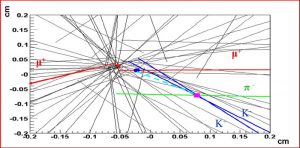
B_s mesons and their antiparticles are produced in pairs in high-energy proton-antiproton collisions. This computer representation shows the decay products of the short-lived candidate particle produced in a collision. The decay products are used to identify the B_s mesons produced in the collision. (Courtesy of DZero collaboration)
The DZero result, suggesting a preferred oscillation frequency between 17 and 21 times per picosecond (trillionth of a second), is described in a paper submitted to the journal, Physical Review Letters. The result, a measure of the oscillation or “mixing” frequency of the particle, has a confidence level of 90 percent, and so does not qualify as a discovery. Physicists have agreed that claims of a discovery must have a confidence level of 99.99995 percent, indicating a 99.99995 percent chance that the result can be reproduced. The data for the DZero result were culled from one inverse femtobarn of total collision data, or more than one billion events from Fermilab’s Tevatron particle accelerator — a milestone capitalizing on the significant luminosity improvements in the Tevatron. The DZero result also sets the stage for future results. Within the next month or so, the CDF collider detector collaboration at Fermilab expects to have a result with greater precision than the DZero result.
“Not only is this an exciting result, but the analysis of a one-inverse-femtobarn data set represents a major milestone for DZero.” said DZero cospokesperson Jerry Blazey of Northern Illinois University. “Next, the Tevatron experiments can focus on obtaining a precise measurement of B_s mixing, which will tell us even more about the curious subatomic world where particles can spontaneously turn into their own antiparticles and back again.”
One of the greatest mysteries of the universe is its apparent composition of only matter, and not antimatter. If matter and antimatter were created equally at the time of the Big Bang, matter and antimatter should have annihilated into pure energy. Clearly, this did not happen. How did our universe of matter survive? Laboratory experiments make it possible to observe some forms of matter oscillating into anti-matter and back. Studying such processes can help solve the mystery of the preponderance of matter in the universe, and DZero has made important progress in this direction.
“We congratulate DZero on this step,” said CDF cospokesperson Rob Roser of Fermilab. “We at CDF are looking forward to our result on a similar size data sample where, given our sensitivity, we expect to get even closer to a discovery.”
Much can be learned about nature by studying matter-antimatter oscillations. In a landmark experiment in the mid 1980’s, a different type of meson (neutral B_d mesons, a b-antiquark and d-quark pair) was observed to oscillate at a much higher rate than theoretical predictions of the day. It was soon realized that this was evidence of the existence of the top quark at a much higher mass than had been expected – as was subsequently confirmed by its discovery at the Tevatron in 1995 by the DZero and CDF collaborations. The DZero limit on B_s oscillation is nearly forty times faster than the oscillation of the B_d meson. Theorists believe the B_s may show sensitivities to massive supersymmetric particles, much as the B_d showed sensitivities to the massive top quark, although this result appears to be inconclusive.
“Many theoretical models of supersymmetry predict a much faster oscillation of B_s mesons than has been reported by DZero, and are therefore disfavored by the new data,” said Fermilab theorist Joseph Lykken, who is not a member of the experiment. “Other approaches to supersymmetry suggest smaller effects; these may be observed with more data, combined with improved searches by DZero and CDF for rare decays of B_s mesons.”
The probe of B_s mixing is one of many ongoing quests for Fermilab scientists during Collider Run II of the Tevatron. Others include the Higgs boson, postulated as the source of mass in the universe; single top quark production, isolating the most massive of quarks, which so far has only been seen to exist in pairs; and New Phenomena, such as new dimensions or supersymmetry.
A meson, such as the B_s, is an unusual particle made up of both matter and antimatter-one quark and one antiquark. The neutral B_s meson is composed of a bottom (or “B”) antiquark and a strange (“s”) quark. The annihilation of matter and antimatter is not a universal event; annihilation occurs when a particle meets its corresponding antiparticle, and both disappear.
While it has been known that the neutral B_s meson (b-antiquark and s-quark) oscillates between matter and antimatter, it has proven difficult to pin down the details. The current theory of matter suggests that B_s mesons oscillate much faster than B_d mesons (anti-bottom quark plus a down quark); consequently, their oscillations are very difficult to detect. Almost all B_s mesons turn into anti-mesons in a fraction of a trillionth of a second. Measuring the frequency of oscillation is of utmost importance, since a deviation from predictions could point to some unexpected new force or interaction lurking around the corner. The DZero experiment has now made an important contribution to this quest and to understanding matter oscillation, by setting the first direct confidence interval on the frequency of the B_s meson oscillations to anti-matter.
DZero is an international experiment of 700 physicists from 90 institutions and 20 countries. Fermilab is a Department of Energy Office of Science national laboratory operated under contract by Universities Research Association, Inc.
The record-breaking performance of the Tevatron collider at the Department of Energy’s Fermi National Accelerator Laboratory is pushing the search for dark matter, supersymmetric particles and extra dimensions to new limits. Repeatedly smashing peak luminosity records, the Tevatron has created record numbers of proton-antiproton collisions that provide the means to unveil the secrets of the universe. Accelerator experts at the lab announced today (March 2) that in only 14 months the Tevatron collider has produced almost five times the data sample collected during four years of Collider Run I (1992-1996), which led to the discovery of the top quark at Fermilab.
Since restarting the Tevatron collider after a scheduled shutdown in December 2004, the collider has produced an integrated luminosity of 872 inverse picobarns-a measure for the number of collisions achieved. Two collider experiments, CDF and DZero, will present new results based on these datasets in the upcoming months.
“High luminosity is the name of the game for particle accelerators,” said DZero co-spokesperson Terry Wyatt, University of Manchester. “We are in a great position to make some exciting discoveries with the data we have. With the prospect of doubling the dataset in 2006 and again in 2007, and with 8,000 inverse picobarns expected by the end of Collider Run II, there is huge future potential.”
Following extensive upgrades, the high-energy Tevatron collider racked up a series of records in 2005 (see footnote), doubling the average peak luminosity-or beam brightness-and raising the world record for peak luminosity at a hadron collider to 17×1031 inverse centimeter square per second. A scheduled shutdown, from the end of February to the middle of June, 2006, is expected to boost the Tevatron performance even further.
Particle physics at colliders is strikingly similar to shooting pool (a.k.a. pocket billiards): the greater the number of collisions created, the greater the likelihood of success. But while one billiard ball classically colliding with another billiard ball always adds up to two billiard balls, the near-light-speed quantum environment of E=mc2 changes the picture completely for particle collisions.
“Imagine a car crash,” said Steve Holmes, Associate Director for Accelerators at Fermilab. “Two 2,500-pound Minis run into each other and, instead of a fender rattling to the pavement, a 6,500-pound Hummer pops out. The more collisions we produce, the better the chance we have of finding something rare.”
The Tevatron uses superconducting magnets to steer protons and antiprotons around a 4-mile ring, creating collisions at the world record energy of close to 2 trillion electron volts (TeV). The challenge in creating the largest possible number of collisions is to produce as many antiprotons as possible and to squeeze them across the smallest achievable area over the longest possible span of time.
Tevatron luminosity depends on having roughly equal numbers of protons and antiprotons in the colliding beams. Producing protons is easy, by particle physics standards: remove the electrons from hydrogen molecules, and you have single protons. Producing antiprotons is not easy, by any standard: colliding beams of protons with a fixed target made of nickel, with every million collisions producing about 18 antiprotons. Ultimately, Tevatron luminosity depends on the number of antiprotons available for collisions.
“In the past 14 months, the peak production rate for antiprotons has increased substantially, from 150 billion antiprotons per hour to 200 billion,” said Roger Dixon, head of the Fermilab Accelerator Division. “We fully integrated the Recycler antiproton storage ring into our accelerator operations, and we greatly increased the antiproton beam density by implementing electron cooling.”
Fermilab spent four years and $260 million to upgrade its accelerators and detectors, from 1996 to 2000. When the lab started Tevatron Collider Run II in March 2001, the progress on luminosity was sluggish. To improve the performance, accelerator experts focused on increasing the antiproton production rate; providing a third stage of antiproton cooling (concentrating the beam using the new Recycler storage ring); and increasing the transfer efficiency of antiprotons to the Tevatron. The result of these steps: more collisions than ever before, and the best prospects for scientific discoveries.
There is no time like the present for Fermilab to make big news with its luminosity improvements. The Large Hadron Collider (LHC) at the European laboratory CERN will be turning on in 2007, with collisions at an energy seven times higher than the Tevatron can produce. Boosting the Tevatron luminosity enhances Fermilab’s chances for discoveries before the LHC creates a significant number of collisions.
“We know that the LHC will assume the high-energy frontier once it is operational, but we also know that discoveries are the best way to position ourselves at the forefront of the field and help us to secure future projects,” says Fermilab Director Pier Oddone. “The Fermilab luminosity upgrades will take us there.”
Details on the luminosity upgrades as well as information on the scientific goals of Collider Run II are available online at: http://www.fnal.gov/pub/today/luminosityseries/index.html
Fermilab is a national laboratory funded by the Office of Science of the U.S. Department of Energy, operated by Universities Research Association, Inc.
Footnote: Between December 2004 and February 2006, the average peak luminosity of the Tevatron collider doubled from 7×1031 cm-2sec-1 to 14×1031 cm-2sec-1. Two charts illustrating the series of luminosity records set during this time period can be found at: http://www.fnal.gov/pub/now/tevlum.html
Upton, NY and Batavia, IL—A global collaboration of physicists and computer scientists announced today the successful completion of a test of the first truly worldwide grid computing infrastructure. Researchers from two national laboratories and ten universities across the United States participated in the test, which saw data transferred around the world at a rate of up to one gigabyte per second.
Today’s scientific discoveries in many fields, including particle physics, require massive amounts of data and the dedication of thousands of researchers. Grid computing transforms the way such scientists plan and conduct research. The current test is a crucial step on the way to making data from the Large Hadron Collider, the world’s largest scientific instrument, available to scientists worldwide when the accelerator begins operating in 2007 at CERN in Geneva, Switzerland. In the current months-long test, or “service challenge,” data were transferred from CERN to 12 major computing centers around the globe, including Brookhaven National Laboratory and Fermi National Accelerator Laboratory, and to more than 20 other computing facilities, ten of which are located at U.S. universities.
“This breakthrough for scientific grid computing comes after years of work by the U.S. particle physics and grid computing communities,” said Saul Gonzalez, associate program manager for U.S. LHC computing at the Office of High Energy Physics in the U.S. Department of Energy’s Office of Science. “The computing centers at Fermilab and Brookhaven have shown that they’re up to the monumental task of receiving and storing terabytes of data from the LHC and serving that data to hundreds of physicists across the United States.”
Focusing on the broader implications of the achievement, Miriam Heller from the National Science Foundation’s Office of Cyberinfrastructure added, “The results of this challenge aren’t just vital for the U.S. and international particle physics community. They also signal the kinds of broad impacts in science, engineering and society in general that can be achieved with shared cyberinfrastructure.”
The global grid infrastructure, organized by the Worldwide LHC Computing Grid collaboration (WLCG), is built from international, regional and national grids such as the Open Science Grid (OSG) in the United States and Enabling Grids for E-SciencE (EGEE) in Europe. Making multiple grids and networks such as the OSG and the EGEE work together as a comprehensive global grid service is one of the biggest challenges for the WLCG.
“Previously, components of a full grid service have been tested on a limited set of resources, a bit like testing the engines or wings of a plane separately,” said Jos Engelen, the Chief Scientific Officer of CERN, commenting from the conference on Computing for High Energy and Nuclear Physics 2006 in Mumbai, India, where the results were announced. “This latest service challenge was the equivalent of a maiden flight for LHC computing. For the first time, several sites in Asia were also involved in this service challenge, making it truly global in scope. Another first was that real physics data was shipped, stored and processed under conditions similar to those expected when scientists start recording results from the LHC.”
In the United States the OSG, together with Brookhaven, Fermilab and other collaborating institutions, provides computational, storage and network resources to fully exploit the scientific potential of two of the major LHC experiments: ATLAS and CMS.
“Much of the data analysis that will lead to scientific discoveries will be performed by the hundreds of particle physicists at U.S. universities,” said Moishe Pripstein from the NSF’s Math and Physical Sciences Division. “University scientists have ramped up their contributions to US CMS and US ATLAS computing, with many already making a significant contribution to the current challenge. The challenge is a remarkable achievement and serves as an important reality check, demonstrating how much work there is yet to be done.”
Brookhaven’s computing facility, which serves as the Tier-1 center for the US ATLAS collaboration, received data at a rate higher than 150 megabytes per second from CERN. The data was then distributed to Tier-2 computing centers at Boston University, Indiana University, the University of Chicago and the University of Texas at Arlington at an aggregate rate of 20 megabytes per second.
“Every LHC discovery about the fundamental properties of matter or the origins of the universe will represent hundreds of users accessing millions of gigabytes of data for analysis,” said Bruce Gibbard from Brookhaven National Laboratory. “We’re well on our way to providing a reliable grid infrastructure to enable research at the forefront of physics.”
Fermilab, the Tier-1 center for the US CMS collaboration, has already set records in data transfer from its computing center to CERN. In this challenge, Fermilab tested its brand-new connections to six Tier-2 centers: Caltech; Purdue University; the University of California, San Diego; the University of Florida; the University of Nebraska-Lincoln and the University of Wisconsin-Madison. Fermilab received data from CERN, archived it and replicated 50 terabytes to the Tier-2 centers where it was stored and retrieved for analysis-all using grid tools and infrastructure.
“This challenge was a learning experience for all of US CMS computing, and for the Tier-2 sites in particular,” said Ken Bloom from the University of Nebraska-Lincoln, Tier-2 coordinator for US CMS. “It was the largest and broadest test we have ever done of our computing capabilities, and, for some of the US Tier-2 sites, the first major interaction with the broader world of LHC computing, yet the six participating sites were among the leaders in the service challenge.”
Notes for Editors
Brookhaven National Laboratory is operated and managed for the U.S. Department of Energy’s Office of Science by Brookhaven Science Associates, a limited-liability company founded by Stony Brook University, the largest academic user of Laboratory facilities, and Battelle, a nonprofit applied science and technology organization.
Fermilab is operated by Universities Research Association, Inc., a consortium of 90 research universities, for the U.S. Department of Energy’s Office of Science.
Further information about the grid infrastructures involved can be found at:
Enabling Grids for E-SciencE (EGEE): http://public.eu-egee.org/
Open Science Grid (OSG): http://www.opensciencegrid.org/
Worldwide LHC Computing Grid (WLCG): http://www.cern.ch/lcg/
Thursday, December 1, 2005, from 5:00 a.m. to 5:00 p.m. CST
Batavia, Ill.—“The Late Show with Leon Lederman” is one of many highlights of a 12-hour live Webcast produced by the European laboratory CERN, the U.S. Department of Energy’s Fermilab and other partners, including physics laboratories, science museums and technology partners. The Web cast, with contributions from around the globe, will celebrate Albert Einstein and look beyond the World Year of Physics 2005. The Webcast will take place on December 1 from 5:00 a.m. to 5:00 p.m. CST. The public will have access to the entire Webcast from the Fermilab homepage at www.fnal.gov.
Nobel laureate and former Fermilab director Lederman will host his show from 2:00-3:30 p.m. live from Fermilab. The show will feature interviews with young physicists, fun physics demonstrations and live music. Journalists interested in attending the live filming of the show at Fermilab should contact Kurt Riesselmann in Fermilab’s Office of Public Affairs at kurtr@fnal.gov or call 630-840-5681. The program of the entire Webcast is available at www.cern.ch/beyondeinstein/
The 12-hour Webcast will be broadcast live on the Internet from several locations. The main Webcast studio will be located in the CERN Globe of Science and Innovation in Geneva, Switzerland. Other locations around the world are connected via videoconference: the Telecom Future Centre (Venice), Imperial College London, Fermilab (Batavia, Illinois), the Exploratorium (San Francisco) hosting scientists from the Stanford Linear Accelerator Center, the Bloomfield Science Museum (Jerusalem) and the National Science Education Centre (Taipei).
From the seven main platforms, “internauts” will be taken on a world tour to physics laboratories and science museums, visiting virtually all the time zones of the planet, from Europe to America, from Asia to Tasmania and as far south as Antarctica.
The program includes subjects such as relativity, gravitational waves, mass and gravity, antimatter and neutrinos, along with the mysteries remaining in Einstein’s physics, and the technologies derived from it. A global audience will be able to discuss the impact of Einstein’s discoveries and look beyond them with top-level physicists such as Stephen Hawking and Paul Davies, and with physics Nobel laureates David Gross, Murray Gell-Mann and Gerard ‘t Hooft, connected from the 2005 Solvay physics Conference in Brussels (10:10 CST).
Einstein was also a refugee, and the United Nations High Commissioner for Refugees (UNHCR) will discuss the positive contribution refugees can make to their society of adoption.
Peter Kirstein from University College London, who was instrumental in the Internet’s early evolution, will be joined by fellow Internet pioneer Bob Kahn, and Robert Cailliau who played a key role at the birth of the Web, to explore the role that basic science plays in the evolution of information technology.
Other highlights include the award ceremony of the Pirelli Relativity Challenge from the Telecom Future Centre in Venice (8:30 CST), and an online quiz for 15 to 19 year-olds. Based on three top mysteries stemming from Einstein’s theories, this competition will offer Apple iBook and Apple iPod prizes to the winners.
Watch the live Webcast and take part in the online quiz on
Thursday, December 1, 2005
5:00 a.m. to 5:00 p.m. CST
http://www.cern.ch/beyondeinstein
The Beyond Einstein partners will be available to answer the press and media questions at a dedicated preview event on the Web on Monday 28 November at 17:00 CET. Join from http://www.cern.ch/beyondeinstein/press
For more information on the Webcast contact:
Fermilab program: kurtr@fnal.gov, phone: 630-840-5681
General information: paola.catapano@cern.ch phone: +41 76 487 36 17
Technical information: silvano.de.gennaro@cern.ch phone: +41 76 487 41 38
Journalists wishing to join the Web press event on November 28 should contact: neil.calder@SLAC.Stanford.EDU
Journalists wishing to join the event in the CERN Globe of Science and Innovation in Geneva on December 1 should contact: Renilde.Vanden.Broeck@cern.ch
Additional media contacts:
Imperial College London:
David Colling, d.colling@imperial.ac.uk, +44 777619 63 61
National Science Education Center Taipei:
Paoti Chang, pchang@phys.ntu.edu.tw, +886 2 33665151
Pirelli Relativity Challenge:
Massimo Armeni, massimo.armeni@pirelli.com, +39 06 69517610
Stanford Linear Accelerator Center:
Neil Calder, neil.calder@SLAC.Stanford.EDU, +1 650-926-8707
The 2005 Solvay Conference in Physics, Brussels:
Marc Henneaux, henneaux@ulb.ac.be, +32 2 650 5423 – 5816
The Bloomfield Science Museum Jerusalem:
Varda Gur Ben Shitrit, varda@mada.org.il, +972-2-6544884
United Nations High Commissioner for Refugees:
Martine Pochon, pochon@unhcr.org, +41 22 7397738
The Exploratorium, San Francisco:
Linda Dackman, lindad@exploratorium.edu, +1-415-561-0363
World Year of Physics International Steering Committee:
Ophelia Fornari, o.fornari@eps.org, +33 3 89 32 94 48
Fermilab is a national laboratory funded by the Office of Science of the U.S. Department of Energy, operated by Universities Research Association, Inc.
MALARGÜE, Argentina — Scientists of the Pierre Auger Observatory, a project to discover the origins of rare and mysterious ultra-high energy cosmic rays, began a celebration today (November 10) in Malargüe, Argentina, to mark the progress on installation of the Observatory’s detectors on the Argentina Pampas, and the presentation of the first physics results.
“These highest-energy cosmic rays are messengers from the extreme universe. They represent a great opportunity for discoveries,” said Nobel Prize winner James Cronin, of the University of Chicago, who conceived the Auger experiment together with Alan Watson of the University of Leeds (UK). Watson added: “How does nature create the conditions to accelerate a tiny particle to such an energy? Tracking these ultrahigh-energy particles back to their sources will answer that question.”
The opening symposium includes presentations on the origins of the project, the construction, and the first science results. Guided tours of the Observatory will be given on Friday, November 11. The events will conclude on Saturday, November 12, with a science fair featuring participants from local schools.
“It is a great pleasure for the Atomic Energy Commission of Argentina to participate in the celebration of the Pierre Auger Project in Malargüe,” said Dr. Cristina Combiaggio, Director of Centro Atomico Constituyentes of CNEA (Comision Nacional de Energia Atomica). “We are very proud of having been able to collaborate with the Project from the very beginning, assuming its leadership in our country, and we commit ourselves to continue providing support.”
The Observatory collaboration includes more than 370 scientists and engineers from 60 institutions in 16 countries, and the construction cost of approximately $50 million has been shared by the participating countries. The Department of Energy Office of Science and the National Science Foundation have combined for approximately $10 million in funding, and the collaboration includes 14 universities in the US. The Observatory also has spawned several high-school based research efforts to study cosmic rays, offering an opportunity for high school students and teachers to be actively involved in cosmic ray research with university mentors.
Said Dr. Robin Staffin, DOE Associate Director of Science for High Energy Physics: “The Pierre Auger Observatory focuses on understanding fundamental and exciting questions in astroparticle physics that are of central importance to the Department of Energy’s Office of Science. We are very pleased that the project’s US collaborators include 14 American research universities in addition to Fermilab, which is providing management and infrastructure support with its extensive experience in managing large international research projects.”
“The Auger scientists have set out on a great scientific adventure, the mystery of Nature’s highest energy particles — where did they come from and how did Nature accelerate them,” said Dr. Michael Turner, NSF Assistant Director, Mathematical and Physical Sciences. “Individual elementary particles carry as much energy as a well-hit baseball. Solving this riddle may cast light on the origins of the Universe and the unification of the forces of Nature as well. Auger also established a new model for international collaboration, with scientists from 16 countries brought together by a compelling problem to build a collaboration from the bottom up. Congratulations to all and happy hunting!”
The Pierre Auger Observatory is trying to solve the mystery of the origins of extremely rare high-energy cosmic rays — charged particles showering the earth at energies above 1019 electron volts, about 10 million times higher than the energy of the world’s highest-energy particle accelerator, the Tevatron at Fermilab. To witness these extremely rare events, the observatory is constructing an array of 1600 detectors spread over 3000 square kilometers in Argentina’s Mendoza Province, just east of the Andes Mountains. Each detector contains 3000 gallons of ultra-pure, de-ionized water. These “Cerenkov detectors” discern the presence of charged particles by measuring the Cerenkov radiation, or electromagnetic shock waves, produced when the particles move through the water faster than the speed of light in the water. The effect is analogous to shock waves generated in the atmosphere by planes flying at supersonic speeds. Information from the detectors is transmitted by solar-powered cellular phone technology.
The detector array covers an area approximately the size of the state of Rhode Island in the United States. Surrounding the array is a set of 24 telescopes which, on clear moonless nights, observe the ultraviolet fluorescence produced as cosmic ray shower particles travel through the atmosphere. While a northern hemisphere site has not yet been funded, the collaboration is working to establish a northern hemisphere partner of the southern observatory, likely to be based in southeastern Colorado in the US. With observatories in both hemispheres, the Auger collaboration will have the opportunity to view cosmic rays across the entire universe, from every direction.
The first physics results from the Pierre Auger Observatory include a new cosmic ray spectrum at the highest energies, the results of anisotropy and point source searches, and new limits on the photon content of the primaries which could address several points within exotic theories of cosmic ray origin. The significance of these results:
- The Observatory charts a spectrum by measuring the observed cosmic rays as a function of energy. As the energy of the cosmic rays increases, the experiment is seeing fewer and fewer of them. Auger observes cosmic rays at energies as high as any other experiment has ever seen, if not higher, examining this high energy range for interesting phenomena — which might or might not exist.
- Cosmic rays generally are charged particles. Lower-energy rays are greatly affected by galactic magnetic fields, taking twisted and distorted paths to earth. High-energy rays, less affected by magnetic fields, take a more direct path to earth. If experimenters see more rays from one direction than from another (anisotropy), they can refine their observations to include point source searches, tracking back fairly closely to a point source or an object in the sky.
- Scientists want to know the makeup of the primaries, the cosmic ray particles that initially strike the earth’s atmosphere, creating further collisions with air molecules that eventually produce a cascade of particles called an extensive air shower. Is the primary a proton, an atomic nucleus, or a photon? Researchers have determined experimentally that the makeup of primaries cannot exceed a specific fraction (a limit) of photons, which will eventually affect their thinking on some exotic theories of cosmic ray origins.
- These exotic theories include hypothetical objects left over from the Big Bang, called topological defects, such as “cosmic strings,” “domain walls,” and “monopoles.” If these hypothetical phenomena existed, and then collapsed, their collapses could produce enough energy to create very high-energy cosmic rays. If so, then a certain fraction of cosmic rays would consist of photons. So far, the data is not extensive enough to prove or disprove any of these phenomena. But enlarging the data set over time will help Auger scientists narrow down the many different theories of cosmic ray origin.
The Pierre Auger Cosmic Ray Observatory is named for French scientist Pierre Victor Auger (1899-1993), who in 1938 was the first to observe the extensive air showers generated by the interaction of very-high-energy cosmic rays with the earth’s atmosphere.
Fermilab, which hosts the project management office for the Pierre Auger Observatory, is a U.S. Department of Energy Office of Science national laboratory, operated under contract by Universities Research Association, Inc. DOE and NSF have designated URA as the US representative on the project’s international oversight board, currently chaired by URA President Fred Bernthal.
More information on Pierre Auger Cosmic Ray Observatory, including visual overview and interview with Nobel Laureate James Cronin: http://www.auger.org/
Pierre Auger Observatory Images: http://www.auger.org/observatory/2004.html
Pierre Auger Observatory Celebration website: http://www.interactions.org/auger/
Auger Observatory Collaborating Institutions by Country
Argentina
Instituto Balseiro, Centro Atómico Bariloche – Comisión Nacional de Energía Atómica y Universidad Nacional de Cuyo
Instituto de Astronomía y Física del Espacio – CONICET
Instituto de Física de La Plata – Universidad Nacional de la Plata y CONICET
Laboratorio TANDAR – Comisión Nacional de Energía Atómica
Universidad Tecnologica Nacional – Regionales Mendoza & San Rafael
Australia
University of Adelaide
Bolivia
Universidad Catolica de Bolivia
Universidad Mayor de San Andres
Brazil
CBPF-Centro Brasileiro de Pesquisas Fisicas
Universidade Estadual de Feira de Santana – Bahia
Universidade Estadual do Sudoeste da Bahia
Universidade Federal da Bahia
Universidade Federal do Rio de Janeiro
Universidade Federal Fluminense
Universidade de Sao Paulo
Universidade Estadual de Campinas
Czech Republic
Institute of Physics of the Academy of Sciences of the Czech Republic
Institute of Particle and Nuclear Physics, Charles University Prague
France
Institut de Physique Nucléaire,Orsay, and IN2P3-CNRS
Laboratoire de l’Accélérateur Linéaire,Orsay, and IN2P3-CNRS
Laboratoire AstroParticule et Cosmologie du Collège de France, and IN2P3-CNRS
Laboratoire de Physique Nucléaire et de Hautes Energies, Université Paris 6, and IN2P3-CNRS
Germany
Forschungszentrum Karlsruhe-Institut für Kernphysik
Forschungszentrum Karlsruhe-Institut für Prozessdatenveratbeitung und Elektronik
Max Planck-Institut für Radioastronomie and Universität Bonn associated by Forschungszentrum Karlsruhe Institut für Kernphysik
Rheinisch-Westfälische Technische Hochschule Aachen
Universität Karlsruhe
Universität Siegen
Bergische Universität Wuppertal
Italy
Dipartimento di Fisica dell’Università and INFN, L’Aquila
Dipartimento di Fisica dell’Università and Sezione INFN, Lecce
Dipartimento di Fisica dell’Università and Sezione INFN, Milano
Dipartimento di Fisica dell’Università and Sezione INFN, Napoli
Dipartimento di Fisica dell’Università di Roma “Tor Vergata” and Sezione INFN Roma II
Dipartimento di Fisica Sperimentale dell’Università and Sezione INFN, Torino
Istituto di Fisica dello Spazio Interplanetario (INAF), Dipartimento di Fisica Generale dell’Università and Sezione INFN, Torino
Sezione INFN di Catania & Dipartimento di Fisica e Astronomia dell’Università, Catania
INFN, Laboratori Nazionali del Gran Sasso
Mexico
Benemérita Universidad Autónoma de Puebla
Centro de Investigacion y de Estudios Avanzados del IPN
Universidad Michoacana de San Nicolás de Hidalgo
Universidad Nacional Autónoma de México
Netherlands
Stichting Astronomisch Onderzoek in Nederland (ASTRON), Dwingeloo
Institute for Mathematics, Astrophysics and Particle Physics (IMAPP), Radboud Universiteit, Nijmegen
Kernfysisch Verneller Instituut (KVI), Rijksuniversiteit Groningen, Groningen
Nationaal Instituut voor Kernfysica en Hoge Energie Fysica (NIKHEF), Nijmegen
Poland
Department of Experimental Physics, University of Lodz
Institute of Nuclear Physics, Krakow
Slovenia
Nova Gorica Polytechnic
Spain
Departamento de Fisica de Particulas, Universidad de Santiago de Compostela
Universidad Complutense de Madrid
Centro de Supercomputacíon de Galicia
Universidad de Alcalá de Henares
United Kingdom
Oxford University
University of Leeds
USA
Case Western Reserve University
Clemson University
Colorado State University
Columbia University
Fermilab National Accelerator Laboratory / Argonne National Laboratory
Louisiana State University/Southern University
Michigan Technological University
Northeastern University
Ohio State University
Pennsylvania State University
University of California, Los Angeles
University of Chicago
University of Colorado
University of Minnesota
University of Nebraska
University of New Mexico
University of Utah
Auger Observatory Funding Agencies by Country
UNESCO
Argentina
La Provincia de Mendoza
Comision Nacional de Energía Atómica
Fundacion Antorchas
Australia
The Australian Research Council
Brazil
Fundacao de Amparo a Pesquisa do Estado de Sao Paulo (FAPESP)
Conselho Nacional de Desenvolvimento Cientifico e Tecnologico (CNPq)
Financiadora de Estudos e Projetos do Ministerio dA Ciencia e Tecnologia (FINEP/MCT)
Czech Republic
Ministry of Education, Youth and Sports of the Czech Republic
France
Centre National de la Recherche Scientifique (CNRS)
Département Sciences de l’Univers (SDU-INSU/CNRS)
Département Physique Nucléaire et Corpusculaire (PNC-IN2P3/CNRS)
Conseil Régional Ile-de-France
Germany
Helmholtz-Gemeinschaft Deutscher Forschungszentren
Bundesministerium für Bildung und Forschung (BMBF), Germany
Deutsche Forschungsgemeinschaft DFG
Finanzministerium Baden-Württemberg
Ministerium für Wissenschaft und Forschung, Nordrhein Westfalen
Italy
Istituto Nazionale di Fisica Nucleare (INFN)
Ministero dell’Istruzione, dell’Università e della Ricerca (MIUR)
Mexico
Consejo Nacional de Ciencia y Tecnología
Netherlands
Ministerie van Onderwijs, Cultuur en Wetenschap
Stichting voor Fundamenteel Onderzoek der Materie (FOM)
Nederlandse Organisatie voor Wetenschappelijk Onderzoek (NWO)
Poland
Ministry of Science and Information Society Technologies
Slovenia
Slovenian Research Agency
Ministry for Higher Education, Science, and Technology
Spain
Ministerio de Educacíon y Ciencia
Xunta de Galicia
FEDER funds
Consejería de Educacíon de la Comunidad de Castilla La Mancha
United Kingdom
Particle Physics and Astronomy Research Council
United States
Department of Energy
National Science Foundation
The Grainger Foundation
BATAVIA, Illinois—When children go to the zoo, or to a museum, or watch a Space Shuttle launch, they want to talk about their experience, and they’re excited about describing what they’ve seen. Science literacy is a critical skill in a world of constantly accelerating technology, and the Department of Energy’s Fermilab Education Office is marking Illinois State Library Family Reading Day with a science-based Family Literacy Experience for Grades K-8 on Thursday, November 17, 2005.
The program will be held in the Leon Lederman Science Education Center, with grade-appropriate sessions running from 3:30 p.m. to 7:15 p.m. Parents will join their children in using hands-on, exemplary science program materials that integrate reading skills and encourage reading. Sessions will be led by local educators in the areas of both science and literacy.
Susan Dahl, manager of teacher resources in the Fermilab Education Office and coordinator for the literacy event, observes that the focus of science instruction at the preschool and elementary levels is on organizing and classifying aspects of nature—the same skills used in organizing and classifying as children learn words in reading and language instruction. At the middle school level, science instruction is focused on analyzing and comparing aspects of nature—just as reading and language instruction is focused on analyzing and comparing ideas.
“Research tells us that we need a context to read effectively, or our brains will discard the words we are reading,” says Dahl. “We want to broaden the idea of literacy. These hands-on science activities, what we call ‘inquiry science,’ will reinforce what children are reading. Parents often ask, ‘How can I help my child learn?’ Here we are offering strategies that can provide substantial help at home. Children will be reading to learn, instead of learning to read.”
The session for Grade PreK is 3:30 p.m. to 4:15 p.m.; for Grades K-1, and Grades 2-3, 4:45 p.m. to 5:45 p.m.; for Grades 4-5, and Grades 6-8, 6:15 p.m. to 7:15 p.m. There will be some cool raffle items for each grade level, and some for parents too. If your family has children in several grades, come to more than one session. Snacks will be available between sessions.
The fee for the Family Literacy Experience is $12 per child with adult companion. To register, first go to www-ed.fnal.gov; then choose “Science Adventures,” and then click on “Family Literacy Experience.”
Fermilab is a Department of Energy Office of Science national laboratory, operated under contract by Universities Research Association Inc.
BATAVIA, Illinois—Preparing for an onslaught of data to be processed and distributed in the upcoming years, scientists at the Department of Energy’s Fermi National Accelerator Laboratory and at the California Institute of Technology successfully tested a new ultrafast data transfer connection developed by the Office of Science of the Department of Energy.
The new DOE UltraScience Net, which allows for the development and testing of dynamically switched fiber-optic links with speeds of up to 20 Gigabits per second, connects cities such as Atlanta, Chicago, Seattle, and Sunnyvale, CA. In a recent test, the transfer of data from a system at Fermilab to a system at Caltech achieved a rate of 7 Gigabits per second, over 15 times faster than with a comparable production Energy Science Network, and thousands of times faster than the usual high-speed Internet connections at private residences.
“With the UltraScience Net, the Department of Energy is at the leading edge of high-speed and high-capacity network research for science applications in the country,” said Fermilab’s Matt Crawford, who led the effort of connecting Fermilab to the Chicago node of the UltraScience Net. “Fermilab is among the first users of the UltraScience Net.”
The UltraScience Net was developed under the leadership of scientists at DOE’s Oak Ridge National Laboratory.
“About two years ago, we looked at various needs for high-speed networking capabilities within the Department of Energy’s science program,” said ORNL’s Nageswara Rao, one of the principal investigators of the UltraScience Net. “From terascale supernova simulations to visualization of genomics data to data from particle collisions, there is a demand for stable, dedicated, high-bandwidth connections to exchange data. With the UltraScience Net, research institutions can book a connection, and nobody can interfere with your circuit while you transfer data at high speed.”
Institutions wanting to use the UltraScience Net are responsible for developing and establishing the links from their sites to the nodes of the UltraScience Net, known as the “last-mile problem.” During the early stage of the UltraScience Net, scientists had to reserve a connection using a Web-based system, and network specialists on both ends of the connection had to manually establish the link at the corresponding time. Since then Fermilab’s network computing experts have developed an automated system called Lambda Station. As its first application, the system automatically can connect computers across Fermilab’s local network with the UltraScience Net when a connection is available.
“The DOE UltraScience Net enables us to think cleverly about networks. We thought of a way to use these ultraspeed channels when they are available, and do without them when they are not,” said Fermilab’s Don Petravick, principal investigator of the Lambda Station project. “The Lambda Station system automatically coordinates the local networks and applications, dynamically assigning network channels using both shared networks and dedicated pipelines. It is a clever package we developed using the wonderful infrastructure provided by the UltraScience Net.”
The successful test of the UltraScience Net and the Lambda Station system is an important milestone for US particle physicists involved in experiments at the Large Hadron Collider, currently under construction at the European laboratory CERN, in Switzerland. In 2007, when the LHC begins producing data, Fermilab will assume the role of a Tier 1 computing center for the CMS experiment at the LHC. As part of its Tier 1 responsibilities, Fermilab will distribute vast amounts of data to universities and other CMS institutions (Tier 2 centers) for analysis.
“The LHC experiments produce large amounts of data, and there is a demand for large data flows among the participating institutions,” said US-CMS physicist, Collaboration Board chair and networking expert Harvey Newman of Caltech, who helped to develop and test the infrastructure of the Lambda Station project. “The UltraScience Net and the Lambda Station infrastructure are key technologies for supporting LHC science. Ultimately, we plan to make the Lambda Station infrastructure available to everybody in the science community who has large data-transfer needs and who has access to high-bandwidth networks.”
Further information is available at:
UltraScience Net: www.csm.ornl.gov/ultranet/
Lambda Station: www.lambdastation.org
CMS experiment at the LHC: http://cmsdoc.cern.ch/cms/outreach/html/
Fermilab is a national laboratory funded by the Office of Science of the U.S. Department of Energy, operated by Universities Research Association, Inc. Caltech’s HEP-related network and grid activities are funded by the U.S. Department of Energy Office of Science and the National Science Foundation.
BATAVIA, Illinois—The Education Office of the Department of Energy’s Fermilab greets the new school year with another complete program of classroom presentations to celebrate the World Year of Physics, marking the 100th anniversary of Albert Einstein’s “Miraculous Year.”
“We reach many students throughout the area with our presentations each year,” said Susan Dahl of Fermilab’s Education Office, “but we’re hoping to reach even more as a way of celebrating the year in which Einstein published the four papers that forever changed the way we view our world.”
The age-appropriate World Year of Physics presentations, taught by Fermilab scientists and geared toward students from grades 2 through 12, are brought free of charge to classrooms, libraries and after-school programs, or to other informal science activities. From “Zap! Light and Color” (Grades 2-6) to “Space, Time and Einstein” (Grades 7-12), the presentations and presenters have made lasting impressions throughout Fermilab’s surrounding school communities.
“I was very pleased with Fermilab’s World Year of Physics presentations,” said Anne Barney of St. Peter’s school in Geneva, Illinois. “The presenters were very knowledgeable, well-prepared, and entertaining. The presentations, perfectly geared toward the student’s grade level, consisted of discussions, visual aids, and hands-on activities. The Fermilab WYoP presentations also introduced to the children a variety of careers in science.”
For fifth-grade teacher Sarah Garcia of Stevenson Elementary School in Melrose Park, Illinois, the classroom presentations even surpassed the experience of a field trip. “I have never seen any of my students so attentive and interested in any educational presentation before,” Garcia said. “They were eager to participate, and eager to show everyone else what they had learned. Our presenter was wonderful and tried to give every student a chance to participate. He even allowed the students to come up after the presentation and work with the demonstrations that they didn’t get to participate in. In my opinion, this was the best ‘field trip’ we had all year. I would highly recommend this to any teacher, and plan to ask Fermilab to come out again this year.”
Classroom presenters are scientists, engineers and technical experts who are dedicated to making educational connections with children in Fermilab’s surrounding communities. Senior scientist Michael Albrow offers “Space, Time and Einstein,” a topic which at first glance appears difficult to translate into hands-on activities: how does one demonstrate relativity? Hula hoops provided one answer.
“To demonstrate bending space, which is a general relativity principle, we had hula hoops with latex sheets stretched across them,” Albrow said. “In the center we placed a heavy steel ball that created a depression in the latex sheet, representing the gravitational welt, then we started a little ball going around and around in circles, heading down toward the big body. We had the kids holding the hula hoops, four kids to each hoop, and we gave no lecture—we just let them have fun.”
Scientist Don Lincoln, who offers “Forces and Motion” (Grades 4-8), noted the active participation, and the sense that the students found science interesting, with applications to their daily lives. “The kids had fun and they all were volunteering to be assistants,” Lincoln said. “They all were offering suggestions when we asked them what they thought would happen. The teachers were grateful to have scientists in the classrooms. With travel budgets so curtailed, this was an inexpensive alternative to a fieldtrip. I was really impressed with just how engaged the students and teachers were.”
The sense of engagement is also rewarding to presenters. Albrow described being touched by the thank-you messages sent from all the members of one class he had visited. “That made it all worthwhile, although it’s also icing on the cake,” he said. “We’re not trying to turn the kids into scientists. We would just like every kid to be exposed to the fun of physics, and to our enthusiasm. We want to show that girls can do science, too—that’s very important, that they can do what they’re interested in doing. And we want to show them how science works, that you always have to test an idea with an experiment.”
The World Year of Physics classroom presentations are offered free of charge to schools within an approximate radius of 90 minutes’ drive from the Fermilab site, which is 40 miles west of Chicago. A brochure with descriptions of all the offerings can be downloaded from the Education Office Website at: http://www-ed.fnal.gov/pdf/wyp_brochure.pdf. To schedule a classroom presentation, contact Nancy Lanning at 630-840-5588. For questions about the program or the presentations, contact Susan Dahl at 630-840-3094.
For more information on the World Year of Physics 2005, an international celebration of physics endorsed by the United Nations, go to: http://www.physics2005.org/
Fermilab is a U.S. Department of Energy Office of Science national laboratory, operated under contract by Universities Research Association, Inc.
BATAVIA, IL – Hundreds of scientists from the DZero collaboration at the Department of Energy’s Fermi National Accelerator Laboratory are using the technology of the future to process particle physics data today. Using grid computing, facilities in six countries around the globe have begun to provide computing power equivalent to 3,000 one-gigahertz Pentium III processors to crunch more experimental data than ever before. In six months, the computers will churn through 250 terabytes of data-enough to fill a stack of CDs as high as France’s Eiffel Tower.
“We’re using the grid to process three years’ worth of data-one billion particle collisions-in six months,” said Fermilab guest scientist Daniel Wicke, on leave from the University of Wuppertal, Germany, who heads the reprocessing effort. “DZero has a long history of using computing resources from outside Fermilab, including a project in 2003 to send a much smaller amount of data off-site for reprocessing. We knew that this much bigger effort, remotely processing ten times more collisions than before using five times the number of computers, would be possible.”
As new data is recorded with the DZero detector at the Tevatron, the world’s highest-energy particle accelerator located in Batavia, IL, it is processed into a form useable by physicists. The cluster of one thousand computer processors dedicated to DZero computing at Fermilab is kept busy processing the newly acquired data.
“The DZero computer farm can process about four million events per day,” said Mike Diesburg, who manages the farm. “At Fermilab, we process data in real time, so even with no new data coming in it would take three years to reprocess three years’ worth of data. To do it in six months we need to look for computing resources all over the world.”
A reprocessing of stored data is necessary when physicists and computer scientists have made significant advances. Researchers are constantly trying to optimize the software to process each collision event faster, and physicists’ understanding of the complex DZero detector is also steadily improving.
“Our scientists are always thinking up new ideas; better ways to calibrate detectors or track particles,” said DZero spokesperson Jerry Blazey. “We wait until many of those ideas have been incorporated into the software and then do a reprocessing. The reprocessed data will improve the full physics program, including detection of top quarks and other elementary particles, and searches for the Higgs boson and new phenomena like supersymmetry.”
As each collision event is processed, the software pulls additional information from large databases, requiring several complex auxiliary systems to work well together at all times. This system then has to be adapted to run on computer systems in many different environments, with many different configurations. Researchers at Fermilab and the participating institutions have been working for almost a year to ensure that the current reprocessing runs smoothly.
“The reprocessing effort pushes the limits of our software and infrastructure so that we can get the most physics out of the data collected by the DZero detector,” said Dugan O’Neil of Simon Fraser University, a participant in the WestGrid collaboration. “The grid allows DZero to make better use of remote human resources as well as computing power. Participating in the reprocessing is an important technical contribution for our group, and it also gives us the experience needed to figure out how to efficiently analyze data remotely.”
Canada’s WestGrid, the University of Texas at Arlington, CCIN2P3 in Lyon, France and FZU in the Czech Republic are the first collaborating sites remotely reprocessing DZero data. Computing centers and grid projects at the University of Oklahoma, GridKa in Germany, and GridPP and PPARC in the U.K. will soon follow. Fermilab scientists hope to eventually add collaborating sites in Brazil, India, Korea and China.
Institutions that have not traditionally collaborated on the DZero experiment also contribute to the reprocessing. The University of Wisconsin is currently contributing computing power, and Fermilab resources primarily dedicated to the CMS experiment at the Large Hadron Collider (LHC) at CERN will soon begin reprocessing. Ultimately, researchers hope to use resources distributed over several international grids, including the Open Science Grid and LHC Computing Grid.
The DZero experiment is a collaboration of about 650 scientists from over 80 institutions in the U.S. and 19 foreign countries. For a list of collaborating institutions, please visit the DZero web site.
Fermilab is operated by Universities Research Association, Inc., a consortium of 90 research universities, for the United States Department of Energy’s Office of Science.
